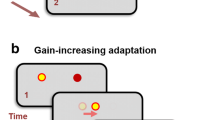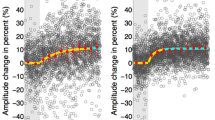Abstract
Commonly, the cerebellum is not associated with cortical components of saccadic eye movement programming. The present study investigates cerebellar effects on visually guided saccades in reflexive tasks (step, gap, overlap) and on internally driven saccades in intentional tasks (anti, memory, short memory sequences of four targets) in five patients with isolated cerebellar atrophy. The cerebellar dysfunction led to impairments in both reflexive and intentional saccades. Cerebellar atrophy patients showed an increase in the gain variability and an increase in the saccade latency. Furthermore, in the memory and anti task, suppression and pro-saccade errors were more frequent in the atrophy group compared to the control group. In the sequence task, patients had difficulties reproducing all four target locations in the order of the displayed sequence. The high variability of the saccade gain is a common observation in cerebellar atrophy patients and can be explained by the general variability present in the saccadic system. The increase in the saccade latency could be due to a cerebellar contribution to cortical processes related to fixation and target selection preceding the initiation of a saccade. Furthermore, the frequent occurrence of saccade errors in the memory and anti task suggests a cerebellar involvement in frontal inhibition of unwanted reflexive saccades. The impaired reproduction of saccade sequences in atrophy patients points to a deficit in short-term memory processes. Thus, this study provides further evidence that the cerebellum is involved in different cortical mechanisms related to the control of saccadic eye movements.




Similar content being viewed by others
References
Akkal D, Dum RP, Strick PL (2007) Supplementary motor area and presupplementary motor area: targets of basal ganglia and cerebellar output. J Neurosci 27(40):10659
Amassian VE, Cracco RQ, Maccabee PJ, Cracco JB (1992) Cerebello-frontal cortical projections in humans studied with the magnetic coil. Electroencephalogr Clin Neurophysiol/Evoked Potentials Sect 85(4):265–272
Barton RA, Harvey PH (2000) Mosaic evolution of brain structure in mammals. Nature 405(6790):1055–1058
Büttner U, Straube A (1995) The effect of cerebellar midline lesions on eye movements. Neuro-ophthalmology 15(2):75–82
Curtis CE, D’esposito M (2003) Success and failure suppressing reflexive behavior. J Cogn Neurosci 15(3):409–418
Daskalakis ZJ, Paradiso GO, Christensen BK, Fitzgerald PB, Gunraj C, Chen R (2004) Exploring the connectivity between the cerebellum and motor cortex in humans. J Physiol 557(2):689–700
Dera T, Boning G, Bardins S, Schneider E (2006) Low-latency video tracking of horizontal, vertical, and torsional eye movements as a basis for 3d of realtime motion control of a head-mounted camera. IEEE, pp 5191–5196
Dieterich M, Bucher S, Seelos K, Brandt T (2000) Cerebellar activation during optokinetic stimulation and saccades. Neurology 54(1):148
Drever J, Straube A, Eggert T (2011) A new method to evaluate order and accuracy of inaccurately and incompletely reproduced movement sequences. Behav Res Methods 43(1):269–277. doi:10.3758/s13428-010-0025-0
Dum RP, Strick PL (2003) An unfolded map of the cerebellar dentate nucleus and its projections to the cerebral cortex. J Neurophysiol 89(1):634
Federighi P, Cevenini G, Dotti MT, Rosini F, Pretegiani E, Federico A, Rufa A (2011) Differences in saccade dynamics between spinocerebellar ataxia 2 and late-onset cerebellar ataxias. Brain 134(3):879
Fetter M, Klockgether T, Schulz J, Faiss J, Koenig E, Dichgans J (1994) Oculomotor abnormalities and MRI findings in idiopathic cerebellar ataxia. J Neurol 241(4):234–241
Fielding J, Corben L, Cremer P, Millist L, White O, Delatycki M (2010) Disruption to higher order processes in Friedreich ataxia. Neuropsychologia 48(1):235–242
Folstein MF, Folstein SE, McHugh PR (1975) “Mini-mental state”. A practical method for grading the cognitive state of patients for the clinician. J Psychiatr Res 12(3):189
Gaymard B, Pierrot Deseilligny C, Rivaud S (1990) Impairment of sequences of memory guided saccades after supplementary motor area lesions. Annals of neurology 28(5):622–626
Gaymard B, Rivaud S, Pierrot-Deseilligny C (1993) Role of the left and right supplementary motor areas in memory-guided saccade sequences. Ann Neurol 34(3):404–406
Glasauer S (2003) Cerebellar contribution to saccades and gaze holding. Ann N Y Acad Sci 1004(1):206–219
Godijn R, Theeuwes J (2002) Programming of endogenous and exogenous saccades: evidence for a competitive integration model. J Exp Psychol Hum Percept Perform 28(5):1039
Goffart L, Chen L, Sparks D (2004) Deficits in saccades and fixation during muscimol inactivation of the caudal fastigial nucleus in the rhesus monkey. J Neurophysiol 92(6):3351
Grosbras MH, Leonards U, Lobel E, Poline JB, LeBihan D, Berthoz A (2001) Human cortical networks for new and familiar sequences of saccades. Cereb Cortex 11(10):936
Guitton D, Buchtel HA, Douglas R (1985) Frontal lobe lesions in man cause difficulties in suppressing reflexive glances and in generating goal-directed saccades. Exp Brain Res 58(3):455–472
Habas C (2010) Functional imaging of the deep cerebellar nuclei: a review. Cerebellum 9(1):22–28
Harting JK (1977) Descending pathways from the superior colliculus: an autoradiographic analysis in the rhesus monkey (Macaca mulatta). J Comp Neurol 173(3):583–612
Hays AV Jr, Richmond BJ, Optican LM (1982) Unix-based multiple-process system, for real-time data acquisition and control. Electron Conventions, El Segundo
Hikosaka O, Miyashita K, Miyachi S, Sakai K, Lu X (1998) Differential roles of the frontal cortex, basal ganglia, and cerebellum in visuomotor sequence learning. Neurobiol Learn Mem 70(1–2):137–149. doi:10.1006/nlme.1998.3844
Hikosaka O, Nakahara H, Rand MK, Sakai K, Lu X, Nakamura K, Miyachi S, Doya K (1999) Parallel neural networks for learning sequential procedures. Trends Neurosci 22(10):464–471
Kojima Y, Soetedjo R, Fuchs AF (2010) Behavior of the oculomotor vermis for five different types of saccade. J Neurophysiol 104(6):3667–3676
Leggio M, Tedesco A, Chiricozzi F, Clausi S, Orsini A, Molinari M (2008) Cognitive sequencing impairment in patients with focal or atrophic cerebellar damage. Brain 131(5):1332–1343
Leigh RJ, Zee DS (1999) The neurology of eye movements, vol 55. Oxford Univ Press
Moschner C, Perlman S, Baloh RW (1994) Comparison of oculomotor findings in the progressive ataxia syndromes. Brain 117(1):15
Moschovakis A, Scudder C, Highstein S (1996) The microscopic anatomy and physiology of the mammalian saccadic system. Prog Neurobiol 50(2–3):133–254
Munoz DP, Everling S (2004) Look away: the anti-saccade task and the voluntary control of eye movement. Nat Rev Neurosci 5(3):218–228
Müri R, Rivaud S, Timsit S, Cornu P, Pierrot-Deseilligny C (1994) The role of the right medial temporal lobe in the control of memory-guided saccades. Exp Brain Res 101(1):165–168
Nitschke MF, Binkofski F, Buccino G, Posse S, Erdmann C, Kömpf D, Seitz RJ, Heide W (2004) Activation of cerebellar hemispheres in spatial memorization of saccadic eye movements: an fMRI study. Hum Brain Mapp 22(2):155–164
Nitschke M, Arp T, Stavrou G, Erdmann C, Heide W (2005) The cerebellum in the cerebro-cerebellar network for the control of eye and hand movements–an fMRI study. Prog Brain Res 148:151–164
Noda H, Sugita S, Ikeda Y (1990) Afferent and efferent connections of the oculomotor region of the fastigial nucleus in the macaque monkey. J Comp Neurol 302(2):330–348
Pierrot-Deseilligny C, Milea D, Müri RM (2004) Eye movement control by the cerebral cortex. Curr Opin Neurol 17(1):17
Quaia C, Lefèvre P, Optican LM (1999) Model of the control of saccades by superior colliculus and cerebellum. J Neurophysiol 82(2):999
Rivaud-Pechoux S, Dürr A, Gaymard B, Cancel G, Ploner CJ, Agid Y, Brice A, Pierrot-Deseilligny C (1998) Eye movement abnormalities correlate with genotype in autosomal dominant cerebellar ataxia type I. Ann Neurol 43(3):297–302
Robinson FR (2000) Role of the cerebellar posterior interpositus nucleus in saccades I. Effect of temporary lesions. J Neurophysiol 84(3):1289–1302
Robinson F, Fuchs A (2001) The role of the cerebellum in voluntary eye movements. Annu Rev Neurosci 24:981–1004
Robinson F, Straube A, Fuchs A (1993) Role of the caudal fastigial nucleus in saccade generation. II. Effects of muscimol inactivation. J Neurophysiol 70(5):1741
Robinson FR, Straube A, Fuchs AF (1997) Participation of caudal fastigial nucleus in smooth pursuit eye movements. II. Effects of muscimol inactivation. J Neurophysiol 78(2):848
Schneider E, Dera T, Bard K, Bardins S, Boening G, Brand T (2005) Eye movement driven head-mounted camera: It looks where the eyes look. IEEE, vol 2433, pp 2437–2442
Sparks DL (2002) The brainstem control of saccadic eye movements. Nat Rev Neurosci 3(12):952–964
Sultan F (2002) Analysis of mammalian brain architecture. Nature 415(6868):133
Takagi M, Zee DS, Tamargo RJ (1998) Effects of lesions of the oculomotor vermis on eye movements in primate: saccades. J Neurophysiol 80(4):1911
Takagi M, Zee DS, Tamargo RJ (2000) Effects of lesions of the oculomotor cerebellar vermis on eye movements in primate: smooth pursuit. J Neurophysiol 83(4):2047
Tedesco AM, Chiricozzi FR, Clausi S, Lupo M, Molinari M, Leggio MG (2011) The cerebellar cognitive profile. Brain 134(12):3672–3686
Thielert CD, Thier P (1993) Patterns of projections from the pontine nuclei and the nucleus reticularis tegmenti pontis to the posterior vermis in the rhesus monkey: a study using retrograde tracers. J Comp Neurol 337(1):113–126
Trappenberg TP, Dorris MC, Munoz DP, Klein RM (2001) A model of saccade initiation based on the competitive integration of exogenous and endogenous signals in the superior colliculus. J Cogn Neurosci 13(2):256–271
Wessel K, Moschner C, Wandinger KP, Kompf D, Heide W (1998) Oculomotor testing in the differential diagnosis of degenerative ataxic disorders. Arch Neurol 55(7):949
Whiting B, Barton R (2003) The evolution of the cortico-cerebellar complex in primates: anatomical connections predict patterns of correlated evolution. J Hum Evol 44(1):3–10
Wiest G, Mueller C, Wessely P, Steinhoff N, Trattnig S, Deecke L (1995) Oculomotor abnormalities in dyssynergia cerebellaris myoclonica. Acta Oto-Laryngologica 115(S520):392–394
Yamada J, Noda H (1987) Afferent and efferent connections of the oculomotor cerebellar vermis in the macaque monkey. J Comp Neurol 265(2):224–241
Zee DS, Yee RD, Cogan DG, Robinson DA, Engel WK (1976) Ocular motor abnormalities in hereditary cerebellar ataxia. Brain: J Neurol 99(2):207
Zee D, Yamazaki A, Butler PH, Gücer G (1981) Effects of ablation of flocculus and paraflocculus of eye movements in primate. J Neurophysiol 46(4):878
Acknowledgments
We thank Katie Ogston for proof-reading the manuscript.
Conflict of interest
The authors declare that they have no conflict of interest.
Author information
Authors and Affiliations
Corresponding author
Rights and permissions
About this article
Cite this article
Filippopulos, F., Eggert, T. & Straube, A. Deficits of cortical oculomotor mechanisms in cerebellar atrophy patients. Exp Brain Res 224, 541–550 (2013). https://doi.org/10.1007/s00221-012-3332-0
Received:
Accepted:
Published:
Issue Date:
DOI: https://doi.org/10.1007/s00221-012-3332-0




